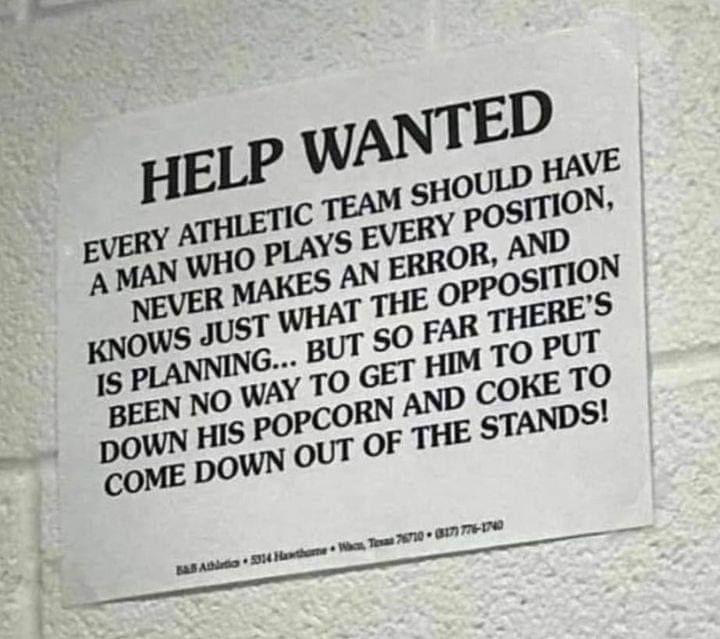Leaderboard
Popular Content
Showing content with the highest reputation on 04/12/2021 in all areas
-
There are probably a few places that still do this, but when I first started working varsity football I was a back judge on a crew that had a game at North Judson. I didn’t notice it (that’s how oblivious I was in those days) before the game, but the local Reserve contingent had a howitzer sitting behind the north end zone. First score of the game for the Bluejays and, much to my surprise, the cannon went off right behind me. I could still get some air in those days, and I got plenty when that thing fired. I think I had to throw away the shorts I was wearing under my knickers.3 points
-
So I am told...... They are waiting on anti-gravity technology. Early adapters.2 points
-
WRC- late 90's/early 2000's addition: Best: Tie- Seeger and Fountain Central. 2 of the best playing surfaces in the league at the time, definitely had the best facilities at the time. Worst: Turkey Run, hands down. I don't remember that field ever having grass on it. Might explain why the Turkey Run kids were so tough. Only reason Attica didn't make it here was because their field actually had some grass on it... Unique: This is a good question. Maybe Riverton Parke, just because it was built on a swamp. The visitor stands was right next to a woods. If you had a second to look around as a player, it was a beautiful setting. But if it was muggy that night, the mosquitos would literally carry you off.1 point
-
They built that building around the old building that housed the scoreboard and then didn't move the scoreboard forward. Remarkably, the only MIC school without an elevator now is Carmel.1 point
-
Very interesting article I got from Referee Magazine online. It briefly addresses a pet peeve of mine: officials having some sort of conference and they’re touching one another with a hand on the arm, arm around the shoulder, whatever. But the article is mainly about contact between players and coaches on one hand, and officials on the other. I confess there have been many times when I helped a player up off the ground. Interestingly, the article doesn’t talk about COVID 19, which is another reason fir a “hands off” policy. What’s Acceptable Contact Between Officials & Participants? The issue of the propriety of any two human beings touching one another runs the gamut of the human condition; from liberal to conservative, man to woman, western to eastern. It has become a particular lightning rod in sports because at times it pits the perception of the officials’ impartiality against the notion that sport is a social endeavor, where human beings express themselves, sometimes by quasi-intimate contact. Nonetheless, the refereeing authorities will tell you that the best policy is to avoid touching players, coaches and each other as much as possible. Oh, there are some exceptions and some issues of common sense, but many officiating leaders feel that drawing the line at zero is the best way to avert two issues. One is with officials who don’t see potential problems that could result. The other is with coaches, players, fans and media who are either paranoid enough or jaded enough to believe anything more than a handshake is proof of collusion. “Because officials are under a microscope from the time they step onto the court until the final buzzer, it is best if they refrain from touching fellow officials, players, coaches and those working around the game due to the sensitivity many have toward touching,” says Debbie Williamson, NCAA women’s basketball consultant as national coordinator and secretary-rules editor. “Officials have numerous ways to communicate during the course of a game and when we can avoid touching others, it is best to do so.” Times Have Changed Randy Krejci is commissioner of the Mississippi Valley Conference, an enclave of 14 major high schools in eastern Iowa. He’s a recently retired middle school principal but also a veteran of numerous state finals as an official in football, basketball and volleyball. He’s been on both sides of the mirror. “In Iowa, some officials have gotten in trouble for even inadvertently touching someone of the opposite sex,” says Krejci. “In the school setting, you have to be very careful that any kind of touching isn’t misconstrued.” He believes that most instances arise from perfectly innocuous events, but since officials are held to a higher standard, they receive less forgiveness. “It can certainly ruin someone’s career if it gets embellished in the media,” he explains. Whether an official is exonerated or not, the mere publicity can be detrimental. Early in his career, Krejci says, he thought nothing of helping players up off the floor or, as an educator, driving a student home if he or she had missed the late bus. Those days are gone and his school district, as an example of most, has very clear policy on when, how and with whom present, to interact with students in any situation. In his own case, as with many of us, it’s led him down the road of having to modify little behaviors that had been natural to him. “If you’re doing things the same way as you did five years ago,” says Dave Libbey, “you’re not keeping up with the times.” Libbey is an eight-time veteran of the men’s basketball Final Four and now the officiating coordinator for the Big West Conference. It’s his perception that the attitude toward personal contact between officials and participants has changed that quickly. It has reached the point that his instructions to his staff are simple: If there’s no management purpose to touching a player or coach, don’t. Avoid Buddy Perception That plows a lot of acreage. Does it mean that from the time the crew walks out on the floor until it zips closed its overnight bags, it should avoid all physical contact with any and all life forms? No, from his point of view, it means that his crews should do whatever is necessary to avoid any situation putting their impartiality or liability at risk. Actually, that allows some leeway. If one of his officials is at Gonzaga and Coach Mark Few thrusts out his hand, is he supposed to spin move away from him? No, says Libbey, because that looks just as suspicious as what he witnesses more often, which is schmoozing ad nauseum. Is the touching that happens normal for the situation? “It doesn’t look good when you’re out there being buddy-buddy (with a coach),” explains Libbey. Coaches at the college level are paranoid of the forces — imagined and real — working against them, he says; seeing the other coach apparently planning his next hunting trip with the zebras gets them going. Libbey even knows of some teams who have their ever-charting assistants keep track of the amount of face time the other coach spends with each official. What Libbey wants is a simple greeting and handshake with a coach and then to get across the floor to make some space. Once there, the next inevitable challenge is the assistant coach who wants to sidle up while the officials are observing the warmup. A friendly handshake is OK there, too, but that’s when Libbey wants his people breaking it off if any attempt is made to start chatting them up. “I just tell them to say, ‘Look, it’s good to see you, but I’ve got to go over here and watch this,’” he explains. That way, onlookers witness that the referee isn’t totally antisocial but is also present to do a job, which doesn’t include exchanging baby pictures. More and more, players on some teams, during introductions, will shake hands with their opponent, the opponent’s coach and then work their way to the nearby officials. The traditionalists will see that as a simple act of sportsmanship. Others may see it as an early indication of oneupsmanship. Officials are again in a bind, because they can more easily look silly rebuffing the overture than they can look suspicious by accepting it. Hands-Off is Best Some of his officials, Libbey says, are still “old school” and used to a more familial approach, including man hugs and friendly pats. Taking the handsoff approach is one of the things both he and John Adams, former NCAA men’s basketball national coordinator, look for in sizing up officials. As far as touching players, Libbey says he can see the point of prudently getting between two players if it helps avert a fight but, other than that, you should never touch them. Laying hands on players who have hit the floor, for example, is definitely out because it might make an injury worse. That’s a good thing to think about the next time you want to help untangle a pile of football players, too. Libbey also reminds us that players and coaches have varying responses to any kind of physical contact when under duress; why risk a short left hook? OK, basketball’s a sport in which the opportunity for physical interaction between officials and participants isn’t great when the clock’s running. There are other sports, like baseball or softball, in which the proximity of the umpire to the catcher, for example, can invite contact, but is that a good thing? Gene McArtor doesn’t think so and, in his role as national coordinator of NCAA baseball umpires, he carries some weight. He agrees with Libbey that there are few good reasons to be touching players or coaches. Baseball, in one respect, is different from other sports because it traditionally tolerates heated confrontations between umpire and contestant. As a Band-Aid, it also promises that touching an umpire will earn a quick thumb and the promise of further penalties. For McArtor, it’s fair, then, that the umpires shouldn’t touch players or coaches, either. Often, though, we’ll see the plate umpire gently lay a hand on the back of the catcher to line up his strike zone, for example. McArtor understands that mechanic but doesn’t want the umpire to maintain that contact. In his view, it would be better if it didn’t happen at all, but he definitely doesn’t want it to persist once the pitcher begins his delivery. It’s an invitation for coaches to claim it distracts their player. “My policy is not 100 percent agreed with by everyone,” McArtor admits, “because it differs from how some of them learned the job. “In my view, though, that’s not the way the game is anymore.” There was a time in soccer when officials in some parts of the world would give players a little shove to get their attention. Italy comes to mind, where some of the greats like Pierluigi Collina could do that and keep their jobs. It seems like wearing water skis to detect land mines in today’s world, but the prevailing powers accepted that the passion on a soccer field sometimes required a more personal touch. Today, players have to settle for a shaved head and menacing look from the likes of England’s Howard Webb, and certainly the USSF frowns on touching, like everyone else. Tony Crush is a national level official with MLS experience and is responsible for referee instruction in Kentucky. “It’s been U.S. Soccer’s position from a liability and game management perspective that we shouldn’t be touching players,” Crush explains. “It can be misconstrued. “Our society asks us to be on the field what we would be in our normal lives. That’s what humanizes us and the players appreciate it.” We also should consider whether touching a crewmate is out of bounds. Certainly, putting an arm around an official of the opposite sex isn’t likely to look much better than attempting the maneuver with a coach. He or she is simply a co-worker, not likely to be your spouse and not likely to appreciate the attention. When it comes to officials of the same gender, the best policy is to handle them no differently than the contestants. Obviously, a handshake or a fist bump, appropriately rendered before or after the contest, is sensible, but remember that fellow officials are under stress, too. If an arm around the shoulder, for example, is calculated to “relieve tension,” it might backfire if your confrere feels patronized, demeaned, cornered or worse. It also doesn’t portray any confidence in your fellow official to the players and coaches if you do that while huddling to discuss a play. It gives the impression that the official is weak and needs a helping hand. A good policy is to treat your relationship with your partners no differently than anyone else. Another Rule to Enforce Sport, all the way down to Little League and Pop Warner, has become big business; an eating machine consuming the passions of all involved, including officials. In anything other than professional wrestling, the arbiters play a big part — and more frequently the decisive part — in maintaining a measure of sanity when the ball’s in play. They help protect the legitimacy that doping, huge salaries and overstated egos have been eroding. Officials are on a big stage with big people and maybe it isn’t asking too much for them to accomplish more by actually doing less when it comes to fraternizing with the participants. Fans are more willing to cast a jaundiced eye on what takes place on the court or field. Psychologists can tell a lot about people by handing them a picture and asking them to make up a story about it. Then they’ll hand the subject a blank card and still hear moving commentaries, but from a much smaller group. More often, the blank card gets no reaction because there’s no stimulus to the imagination. Officials must be that blank card today. Whenever they’re in public they must portray impartiality. Supervisors are telling us that touching a person any differently on the field than you would in the office or gym or church can bring that impartiality into question. Like Krejci says, that question of propriety doesn’t have to have an answer. Like Crush says, people want to see us fit the bill, so back-patting, group hugging or an arm around the waist doesn’t cut it anymore. Many of the referees who would push back on a hands-off policy would argue, “I gotta be me.” Asking them to keep their hands in their pockets would be like asking them to work the game on crutches, as the rationale goes. Crush, for one, disagrees. He sees all sorts of Type A personalities walk in off the street and manage to comply with federation policy. It’s just another rule to enforce, albeit a personal one. The reality is that 50 people could have been interviewed for this story with the likelihood of few, if any, disagreeing that an absolute no-touching policy is best. Most people at a game have no idea what officials are thinking, and few can hear what they say, but they can see what they do and what they look like. Body type is equated with fitness. Sculpting of signals is a measure of commitment. Mannerisms are a predictor of emotion. Invading someone’s personal space with a pat or a full-length hug is an indication of what? Those other things tie to what people expect an official to do, while touching a person goes outside the lines. It’s more likely to be considered a sign of personal interest: That’s not the image assigners want, nor is it what most officials want. Not touching someone, other than when it’s the polite thing to do, is the order of the day. Remember this: What would someone you care about think if they were told where you had your hands on another person, without telling them you were working a game when you did it? If you would have some explaining to do, you probably shouldn’t have been doing it. Use your head, not your hands.1 point
-
Unique.. Dugger Union was always interesting... folks could just back their truck up within a few feet of the field. Pike Central mid 1990's- I remember the crown on the field was so high... you couldn't see below the knee at the 50. Best... Linton's Roy Williams Field is a pretty good place to watch a big game. I may be a little partial. Other thoughts... I like North Vermillion's field... the grass always seems to be in top notch condition Vincennes has a mixture of history/new facilities... I'm glad to see it is still being used after years of rumors to move them to the HS. Eastern Hancock- The coldest I have ever been standing on top of a press box was there. It was semi-state... cold... and really windy. Reitz Bowl- Really cool atmosphere with it sunken in around a whole neighborhood. It would be amazing with a grass field. The turf seems out of place and is in poor condition. Bosse's Enlow FIeld- We have only had scrimmages there, but it is a cool place. Grass would fit the atmosphere, but their turf is in good shape. Tell City is an interesting setting in the middle of town... sort of reminded me of Linton with fans outside of the stadium playing a role in the atmosphere.1 point
-
Wish this matchup would have happened last year or the year before. We'll see how the underclassmen develop, but I think next year will be a very tough year for Chatard. I believe they are only returning 1-2 players on both sides of the ball, and their current junior and sophomore classes don't have the same level of talent of previous teams. I still love that Coach Doyle put this one on the schedule, but I think it could get ugly for my trojans.1 point
-
Made that hike a couple times at X. It is a great environment. Still hate them, but incredible environment. 😁 The most noticeable thing is no track, so the fans are on top of you. But yeah, that climb.....unreal1 point
-
Or us, we are close to 2A enrollment playing 4A for what, 2 more years? Hard to figure...1 point
-
In my experience, some coaches are very good about helping with this. Some are not. I would think at this point, all your son needs to do it make a Hudl highlight film and attend a summer camp or two at colleges he may be interested in. As he gets older, either the coach or you can contact coaches that he may be interested in attending. I don't think I would do that until before his junior season at the earliest.1 point
This leaderboard is set to Indiana - Indianapolis/GMT-04:00








